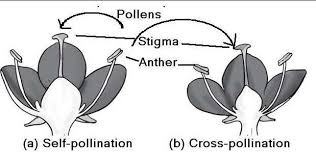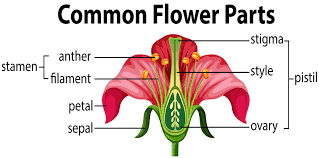CROSS POLLINATION- MECHANISM AND CONSEQUENCES
DEFINITION
When pollen is transferred from the stamen of a flower to the stigma of a flower on another plant, called cross-pollination.
It is also known as allogamy. The transmissions of pollens are carried by wind, water and insects.


MECHANISM PROMOTING CROSS POLLINATION
There are several mechanisms which prevent self-pollination or say promotes cross pollination. For example, the reproductive organs may be arranged in such a way that self-fertilization is unlikely, or the reproductive organs may mature at different times.
Let’s see one by one.
- Dicliny or Uni-sexuality- It is the condition where stamens and pistils lie on separate flowers or in other words, flowers are either staminate or pistillate, i.e. imperfect flowers.
- Monoecious plants- Staminate and pistillate flowers are found on the same plant either in the same inflorescence (e.g. castor, mango, banana and coconut) or in the different inflorescence, e.g. maize.
- Dioecious plants- Here staminate and pistillate flowers are found on different plants, e.g. papaya, dates, hemp, asparagus, spinach.
- Dichogamy- here stamens and pistils of hermaphrodite flowers mature at different times. It is of two types-
- Protogyny- here pistil mature earlier to stamens, e.g. bajra.
- Protandry- here stamens mature earlier to pistils, e.g. maize, sugerbeet.
- Presence of mechanical barrier- In some plants, such as lucerne, stigma is covered with a waxy film which is broken by visit of honeybees facilitates cross-pollination.
- Self-incompatibility- Male and female gametes are fertile, but pollens fail to fertilize the same flower or other flowers on the same plant due to some oppositional factors. E.g. tomato, tobacco, mango, mustard, radish, cabbage etc.
- Male sterility- here female gamete is fully functional but male gametes are non-functional. Male sterility is determined by genetic factors or cytoplasmic factors. It is not common in natural populations.
CONSEQUENCES
- It promotes heterozygosity. It leads to greater genetic diversity because the male and female gametes are derived from different plants.
- The genetic diversity is required for survival in changing environment or stress condition. Cross-pollination improves the resistance of the offspring to diseases and changes in the environment.
- Seeds from cross-pollination have good vigor and vitality.
- There is advantage and disadvantage both from cross pollination in respect of trait or character. Because of, if there are any recessive characters in the lineage, they are eliminated as a result of genetic recombination, also there are high chances that the good qualities may get eliminated and unwanted characteristics may get added due to recombination of the genes.
Read more…
REPRODUCTION IN PLANTS
WHAT IS POLLINATION- PROCESS & MECHANISM
SELF POLLINATION- MECHANISM & CONSEQUENCES
PLANT HORMONES- FACTS, TYPES & EFFECTS
DIFFERENCE BETWEEN DIFFUSION AND OSMOSIS
WHAT IS ENZYME- NATURE AND PROPERTIES